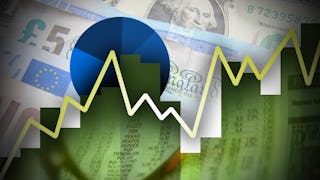We make economics decisions every day: what to buy, whether to work or play, what to study. We respond to markets all the time: prices influence our decisions, markets signal where to put effort, they direct firms to produce certain goods over others. Economics is all around us.

Enjoy unlimited growth with a year of Coursera Plus for $199 (regularly $399). Save now.

(1,657 reviews)
Skills you'll gain
Details to know

Add to your LinkedIn profile
18 assignments
See how employees at top companies are mastering in-demand skills

There are 5 modules in this course
Where do markets come from? We will start with understanding the constraint of scarcity that we face and the concept of opportunity cost that reflects the true cost of any decision we make. We will learn to model scarcity using the Production Possibilities Frontier that allows us to visualize tradeoffs, distinguish between efficient, inefficient and unattainable points. We will also discuss how economic growth affects our options and allows us to achieve the previously unattainable.
What's included
17 videos2 readings3 assignments1 discussion prompt
Trade allows us to achieve the unattainable- we can consume more than we can produce on our own. We will introduce the concept of Comparative Advantage and discuss how gains from specialization allow us to use our resources efficiently. We will apply these concepts to a simple model of trade, showing that now the Consumption Possibilities Frontier allows points outside the Production Possibilities Frontier.
What's included
14 videos1 reading2 assignments1 discussion prompt
We will introduce the central model of Supply & Demand. This will allow you to communicate with other economists and finally understand those business pages and market updates. We will distinguish between a movement along and a movement of the supply & demand curves. We will define market equilibrium as understand that at an equilibrium price there is neither excess demand nor excess supply. We will end by a few scenarios where exogenous changes affect supply and/or demand and analyze the impact on equilibrium price and quantity.
What's included
15 videos1 reading4 assignments1 discussion prompt
There is a lot of terminology this week. We will introduce of the concept of elasticity of demand that measures the responsiveness of quantity demanded to a change in the price of a good. We will explore the relationship between change in price and revenue or sales and how elasticities can help us predict whether a decrease in price will increase or decrease revenue. We then introduce other elasticities of note: cross price elasticity, income elasticity and elasticity of supply. We end the week by exploring the great accomplishment of markets: maximizing the size of the pie or the total benefit to society.
What's included
23 videos1 reading4 assignments1 discussion prompt
In week four we learnt that the markets maximize the surplus that can be generated. So what happens if the government steps in and intervenes in the market? This week we will analyze price floors and ceilings, taxes and subsidies and learn how the best intentions sometimes lead to very unfortunate results.
What's included
16 videos1 reading5 assignments1 discussion prompt
Instructor

Offered by
Explore more from Economics
 Status: Preview
Status: PreviewO.P. Jindal Global University
 Status: Free Trial
Status: Free TrialRice University
 Status: Preview
Status: PreviewUniversity of Rochester
 Status: Free Trial
Status: Free TrialRice University
Why people choose Coursera for their career




Learner reviews
1,657 reviews
- 5 stars
79.54%
- 4 stars
17.07%
- 3 stars
2.59%
- 2 stars
0.42%
- 1 star
0.36%
Showing 3 of 1657
Reviewed on May 16, 2020
The information I gained during this course will surely help me in becoming a better economist in the future and I found all the concepts quite easy as they were explained very well.
Reviewed on Jan 13, 2017
I really enjoyed the clarity with which the concepts were taught. I loved the examples and I thought they were very helpful and made the concepts so much easier to understand.
Reviewed on Mar 2, 2016
Nice lecture and quizzes. Easy to follow and very encouraging for those who is new to coursera or has failed to finish online courses within deadline before (like me).
Frequently asked questions
To access the course materials, assignments and to earn a Certificate, you will need to purchase the Certificate experience when you enroll in a course. You can try a Free Trial instead, or apply for Financial Aid. The course may offer 'Full Course, No Certificate' instead. This option lets you see all course materials, submit required assessments, and get a final grade. This also means that you will not be able to purchase a Certificate experience.
When you purchase a Certificate you get access to all course materials, including graded assignments. Upon completing the course, your electronic Certificate will be added to your Accomplishments page - from there, you can print your Certificate or add it to your LinkedIn profile.
Yes. In select learning programs, you can apply for financial aid or a scholarship if you can’t afford the enrollment fee. If fin aid or scholarship is available for your learning program selection, you’ll find a link to apply on the description page.
More questions
Financial aid available,





